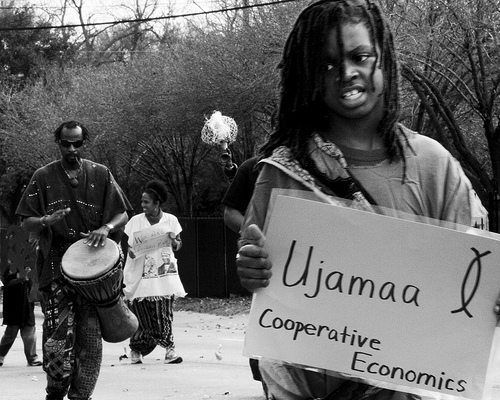6 Historic Examples of Cooperative Economics (Ujamaa) That Advanced The Black Community
“There exists today a chance for [Blacks] to organize a cooperative State within their own group. By letting Negro farmers feed Negro artisans, and Negro technicians guide [Black] home industries and [Black] thinkers plan this integration of cooperation, while [Black] artists dramatize and beautify the struggle, economic independence can be achieved. To doubt that this is possible is to doubt the essential humanity and the quality of brains of [Black People].”
W.E.B. DuBois, 1935
#1. Susu
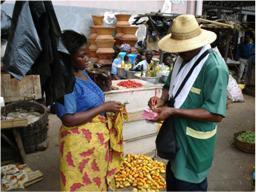 In parts of West Africa and the Caribbean an ancient version of cooperative economics exists, called “susu.” As one of the oldest forms of microfinance in Africa, the practice is run by one of Africa’s oldest financial groups, susu collectors. They run their businesses from kiosks in the marketplace and act as mobile bankers. Clients make low but regular deposits on a daily or weekly basis over the course of a month into a susu account. At the end of this period the susu collector returns the accumulated savings to the client but keeps one day’s savings as commission. Susu collectors may also provide advances to their clients or rotate the accumulated deposits of a group between individual members. Today, susu collectors provide many West Africans who would otherwise be denied credit with access to money they need to start up small venture projects that in many cases benefit the community as a whole. In the United States, Black immigrants from the Caribbean have enjoyed one of the highest economic growth rates using a form of the susu and leveraging this practice to establish successful credit unions.
In parts of West Africa and the Caribbean an ancient version of cooperative economics exists, called “susu.” As one of the oldest forms of microfinance in Africa, the practice is run by one of Africa’s oldest financial groups, susu collectors. They run their businesses from kiosks in the marketplace and act as mobile bankers. Clients make low but regular deposits on a daily or weekly basis over the course of a month into a susu account. At the end of this period the susu collector returns the accumulated savings to the client but keeps one day’s savings as commission. Susu collectors may also provide advances to their clients or rotate the accumulated deposits of a group between individual members. Today, susu collectors provide many West Africans who would otherwise be denied credit with access to money they need to start up small venture projects that in many cases benefit the community as a whole. In the United States, Black immigrants from the Caribbean have enjoyed one of the highest economic growth rates using a form of the susu and leveraging this practice to establish successful credit unions.
 2. Colored Farmers’ National Alliance and Cooperative Union (CFACU)
2. Colored Farmers’ National Alliance and Cooperative Union (CFACU)
The Colored Farmers’ National Alliance and Cooperative Union was formed in 1886 in Texas. Despite the fact that both Black and white farmers faced great difficulties due to the rising price of farming and the decreasing profits that were coming from farming, the protective organization known as the Southern Farmers’ Alliance didn’t allow Black farmers to join.
A group of Black farmers decided to organize their own alliance, to fill their need. The CFACU operated under fear and harassment by white farmers, but managed to operate several cooperatives in the late 19th century before having to disband.
Members of the CFACU shared agricultural techniques and innovations, and coordinated cooperative efforts for planting and harvesting. The Union promoted alliances between farmers and laborers, and was active in local and regional politics in order to maintain rights for African Americans after Reconstruction. It’s estimated that the CFACU had 1.2 million members and was the largest Black organization of its time.
3. Universal Negro Improvement Association (UNIA)
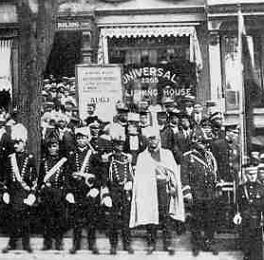 In 1914 Marcus Garvey founded the Universal Negro Improvement Association (UNIA), the largest movement across territorial borders among the African peoples during the 20th century. By the early 1920s the UNIA could count branches in almost every Caribbean, Latin America, and sub-Saharan African country with membership swelling to 8 million. Under Garvey’s leadership, the UNIA encouraged entrepreneurship, attracted millions of Black people to buying from Black-owned business.
In 1914 Marcus Garvey founded the Universal Negro Improvement Association (UNIA), the largest movement across territorial borders among the African peoples during the 20th century. By the early 1920s the UNIA could count branches in almost every Caribbean, Latin America, and sub-Saharan African country with membership swelling to 8 million. Under Garvey’s leadership, the UNIA encouraged entrepreneurship, attracted millions of Black people to buying from Black-owned business.
Established in 1919, the Negro Factories Corporation, one of the UNIA’s ventures, with a capitalization of $1 million, sought to build and operate factories in the big industrial centers of the United States, Central America, the West Indies and Africa. It generated income and provided about 700 jobs by its numerous enterprises: three grocery stores, two restaurants, a laundry, a tailor shop, a dress-making shop, a millinery store, a printing company and doll factory.
Incorporated in Delaware as a domestic corporation on June 27, 1919, the Black Star Line Inc. was capitalized at $10 million. It sold shares individually valued at $5 to both UNIA members and non-members alike. Proceeds from stock sales were used to purchase ships to facilitate the transportation of goods and eventually African Americans throughout the African global economy.
4. Colored Merchants’ Association
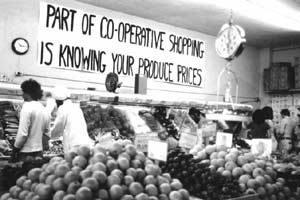 In 1928, the National Negro Business League of Montgomery, Ala., established the Colored Merchants’ Association (CMA), a cooperative organization of Black grocery stores. The purpose of the organization was to reduce the operating costs of Black retailers through mutual support, cooperative buying, and collective marketing — in a harsh market dominated by White-owned chain stores. The CMA model was markedly successful. Associated stores reported increases in business and profits. The association spread to nearly 18 cities, including Chicago, Philadelphia, Nashville, Dallas and New York. The CMA built its national headquarters in New York City in October 1929. Chapters were organized in cities with 10 or more stores. CMA members paid $5 per month per store and were required to meet designated standards. By 1930, 253 stores were part of the CMA network. Members received support services from the association, such as intensive training in merchandising techniques, sales training, advertising, and management resources such as market analysis, inventory and bookkeeping systems, and collection and credit procedures.
In 1928, the National Negro Business League of Montgomery, Ala., established the Colored Merchants’ Association (CMA), a cooperative organization of Black grocery stores. The purpose of the organization was to reduce the operating costs of Black retailers through mutual support, cooperative buying, and collective marketing — in a harsh market dominated by White-owned chain stores. The CMA model was markedly successful. Associated stores reported increases in business and profits. The association spread to nearly 18 cities, including Chicago, Philadelphia, Nashville, Dallas and New York. The CMA built its national headquarters in New York City in October 1929. Chapters were organized in cities with 10 or more stores. CMA members paid $5 per month per store and were required to meet designated standards. By 1930, 253 stores were part of the CMA network. Members received support services from the association, such as intensive training in merchandising techniques, sales training, advertising, and management resources such as market analysis, inventory and bookkeeping systems, and collection and credit procedures.
5. Federation of Southern Cooperatives
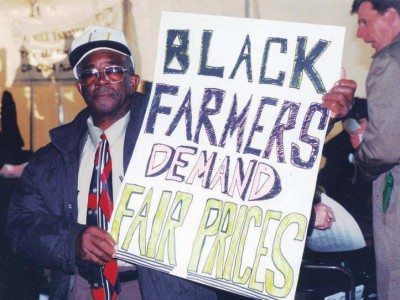 Federation of Southern Cooperatives was a nonprofit organization of state associations founded in 1967 in Atlanta for the purpose of supporting predominantly Black cooperatives in southern states. The organization later merged with the Land Emergency Fund to become the Federation of Southern Cooperatives/Land Assistance Fund.
Federation of Southern Cooperatives was a nonprofit organization of state associations founded in 1967 in Atlanta for the purpose of supporting predominantly Black cooperatives in southern states. The organization later merged with the Land Emergency Fund to become the Federation of Southern Cooperatives/Land Assistance Fund.
Member cooperatives engage in organic farming, marketing, agricultural processing, fishing, sewing, handicrafts, land buying, grocery cooperatives, and credit unions. The organization established six state offices and a rural training and research center. It also engages in state and federal policy advocacy and provides technical assistance to protect Black-owned land and maintain Black land ownership, as well as promotes sustainable family farming and cooperative development.
The Federation also provides emergency services to its members during times of natural disaster. In its 45-year history, the organization has helped to create and/or support more than 200 cooperatives and credit unions mostly in the 11 states where it operates (Alabama, Arkansas, Florida, Georgia, Kentucky, Louisiana, Missouri, Mississippi, South Carolina, Tennessee, Texas, and the Virgin Islands).
The Federation owns and runs a rural training and research center in Epes, Ala., that showcases sustainable forestry, provides co-op education, and helps to develop Black youth-run co-ops (such as Sankofa Youth Cooperative). Its headquarters is in East Point, Ga. The FSC/LAF also engages in cooperative development in Africa and the Caribbean.
6. Leonard Percival Howell, The Rastafari Movement & Pinnacle
PINNACLE was/is the first self-sustaining community in Colonial Jamaica. Established by Leonard Percival Howell in 1940 from a small community of 700, to a flourishing community of over 4,000 residents with Organic Farms, Schools, A Community Bakery, a Block Making Factory, and Bio-Friendly Homes constructed of bamboo.
In 1937, Howell established the friendly organization known as the Ethiopian Salvation Society, and in 1940 started the first Rastafari Community in the hills of the parish of St. Catherine, Jamaica. Members received plots on which they built houses made of wood with thatched roofs, and on which they cultivated food crops for subsistence and sales. They also made household items, such as mats and brooms, and they burned coal for use in the community, and to sell in the markets in Spanish Town and downtown Kingston.
Howell also started a Bakery, which brought in cash. Pinnacle was similar to a Maroon village in that it was self-governed. There was a Communal Dining Room, and a place where everyone went to Worship. When Pinnacle was raided in 1954, a total of £4,000 cash was seized by authorities. The true economic viability of the village can be measured by considering the following:
If you want to compare the value of a £4,000 by Income or Wealth in 1954 to today, there are three choices. In 2013 the relative:
historic standard of living value of that income or wealth is £95,550.00
economic status value of that income or wealth is £278,500.00
economic power value of that income or wealth is £349,500.00
In its heyday, The Pinnacle served as a testament to the strength of Communal Cooperative Living, Organic Farming, Independent Education, and Herbal/Indigenous Therapies. Many of the modern Cancer medicines derive from the extracts of the Rosy Periwinkle (Catharanthus roseus), first identified in Jamaica. The Rosy Periwinkle was utilized by Mr. Howell in Herbal Medicines and Health Tonics which Rastafarians/Howellites mass-produced and sold to the local government, private, and public sectors. While in Mid-Century Colonial Jamaica, Dr. Howell was labelled a charlatan guilty of medical malpractice, it is now clear he was more of a visionary with a world view that is ripe for implementation.



